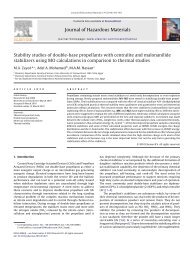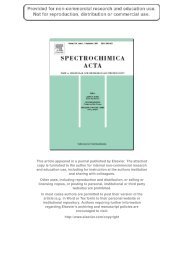Spectrophotometric determination of carbamazepine ... - MA Zayed
Spectrophotometric determination of carbamazepine ... - MA Zayed
Spectrophotometric determination of carbamazepine ... - MA Zayed
Create successful ePaper yourself
Turn your PDF publications into a flip-book with our unique Google optimized e-Paper software.
<strong>Spectrophotometric</strong> <strong>determination</strong> <strong>of</strong> <strong>carbamazepine</strong> and mosapride citrate in pure and<br />
pharmaceutical preparations.<br />
Eman Y.Z. Frag, M.A. <strong>Zayed</strong>*, M.M. Omar, Sally E.A. Elashery, Gehad G. Mohamed<br />
Chemistry Department, Faculty <strong>of</strong> Science, Cairo University, Gamaa Str., 12613, Giza, Egypt<br />
* Author for whom all correspondence should be addressed. (e-mail: mazayed429@yahoo.com)<br />
Abstract<br />
Simple, rapid and sensitive spectrophotometric methods were developed for the <strong>determination</strong><br />
<strong>of</strong> <strong>carbamazepine</strong> and mosapride citrate drugs in pure and pharmaceutical dosage forms. These<br />
methods are based on ion pair and charge transfer complexation reactions. The first method is<br />
based on the reaction <strong>of</strong> the <strong>carbamazepine</strong> drug with Mo(V)-thiocyanate in hydrochloric acid<br />
medium followed by extraction <strong>of</strong> the coloured ion-pair with 1,2-dichloroethane and measured at<br />
470 nm. The second method is based on the formation <strong>of</strong> ion-pairs between mosapride citrate and<br />
two dyestuff reagents namely bromothymol blue (BTB) and bromocresol green (BCG) in universal<br />
buffer <strong>of</strong> pH 4 and 3, respectively. The formed ion-pairs are extracted with chlor<strong>of</strong>orm and<br />
methylene chloride and measured at 412 and 416 nm for BTB and BCG reagents, respectively. The<br />
third method is based on charge transfer complex formation between mosapride citrate (electron<br />
donor) and DDQ (π-acceptor reagent) and measurements at 450 nm. All the optimum conditions<br />
are established. The calibration graphs are rectilinear in the concentration ranges 10-350 for<br />
<strong>carbamazepine</strong> using Mo(V)-thiocyanate and 4-100, 4-60 and 10-150 μg mL -1 for mosapride citrate<br />
using BTB, BCG and DDQ reagents, respectively. The Sandell sensitivity (S), molar absorptivity,<br />
correlation coefficient, regression equations and limits <strong>of</strong> detection (LOD) and quantification<br />
(LOQ) are calculated. The law values <strong>of</strong> standard deviation (0.04-0.09 for <strong>carbamazepine</strong> using<br />
Mo(V)-thiocyanate and 0.022-0.024, 0.013-0.018 and 0.013-0.020 for mosapride citrate using<br />
BTB, BCG and DDQ, respectively) and relative standard deviation (0.630-2.170 for <strong>carbamazepine</strong><br />
using Mo(V)-thiocyanate and 0.123-1.43, 0.102-0.530 and 0.226-1.280 for mosapride citrate using<br />
BTB, BCG and DDQ, respectively) reflect the accuracy and precision <strong>of</strong> the proposed methods.<br />
The methods are applied for the assay <strong>of</strong> the investigated two drugs in pharmaceutical dosage<br />
forms. The results are in good agreement with those obtained by the <strong>of</strong>ficial method.<br />
Keywords: Carbamazepine and mosapride citrate; Ion-pair formation; Charge transfer;<br />
Spectrophotometry.<br />
2






